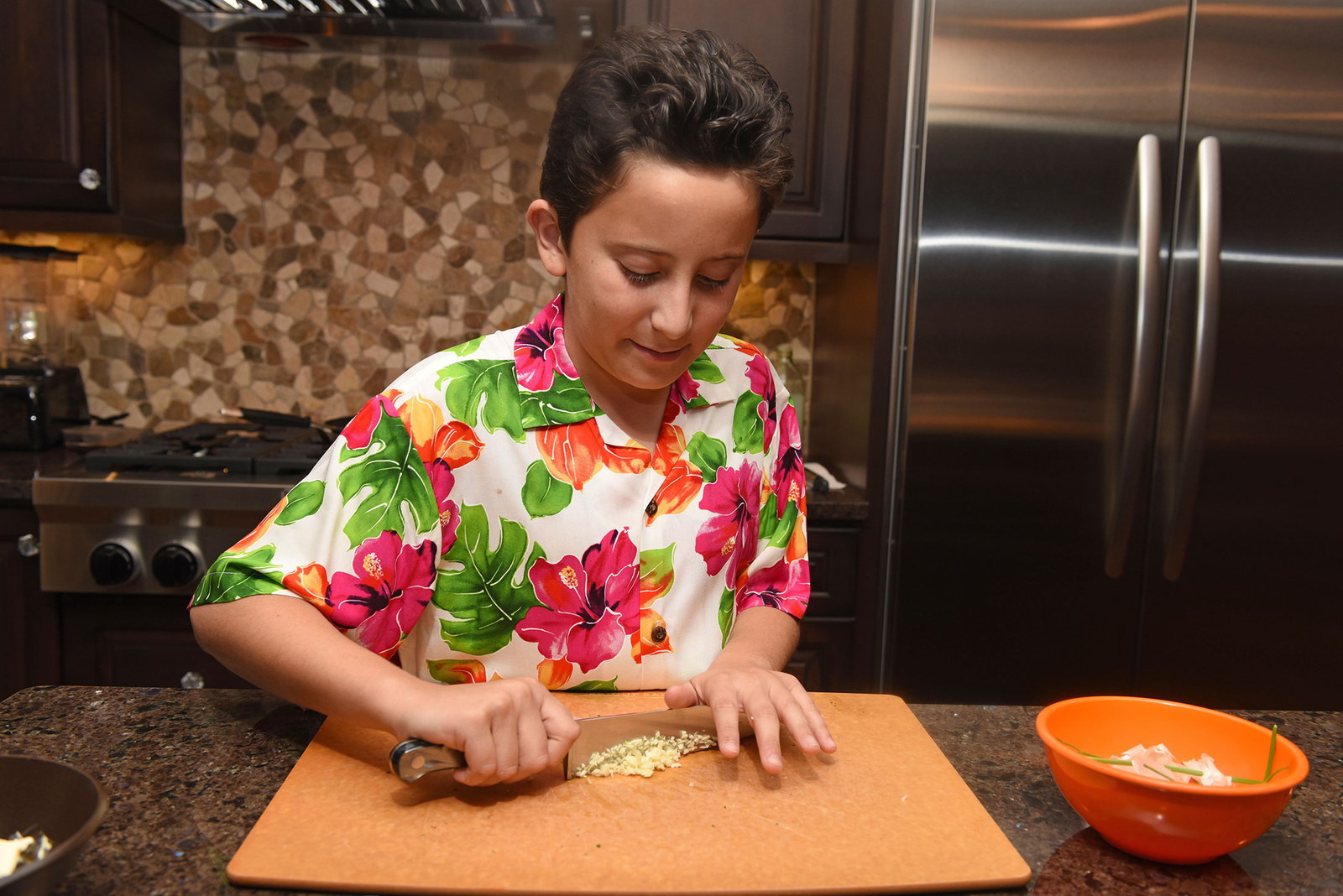The 12-year-old boy standing in front of Gordon Ramsay has just started to cry. He’s wearing a floral bow tie, a plaid collared shirt tucked neatly into slim black jeans, and a bright white apron tied at the waist with his name embroidered on it in all caps, “LOGAN,” along with the logo of the show on which he is one of the final eight contestants, MasterChef Junior. His two front teeth are gapped, and his sandy blond hair is parted way over on one side. When he grows up, Logan wants to be an oceanographer, an astronaut, a chef, and a garbageman. The restaurant he plans to open someday will be called “O’s Underwater Bistro” and it will have special bubbles, some “executive bubbles” and some “romantic bubbles,” where customers will dine floating around underwater separate from the main restaurant, like in submarines.
But today, Logan has overcooked and underseasoned the rice in what he says would be the signature dish at his underwater bistro. The 82-pound, 4-foot-11-inch boy from Memphis, who, unlike some of the other contestants, can actually see over the cooking counters on the MasterChef set, has had one hour to create this dish, presumably without any adult assistance. And though his perfectly seared steak has “nice char and color,” the plate overall is too simple — lackluster, Ramsay says. As the British celebrity chef tells Logan that “the judges have come to expect more from you, young man,” a tear so giant that even I can see it from behind the cameras 30 feet away drops off Logan’s cheek and hits the floor. The boy’s shoulders curve forward, his head drops, and he’s sobbing.
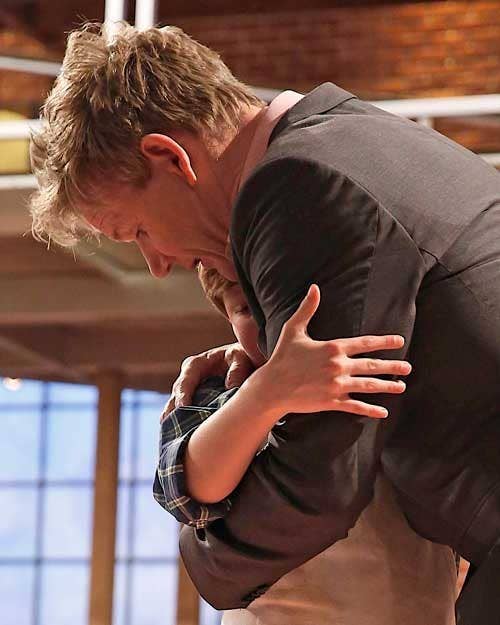
Producers backstage stop whispering into their mics. The cameramen are still and tense. No one likes to see a child cry. But then Ramsay, who has seven Michelin stars, 25 restaurants, and a reputation for calling the cooks on his TV shows things like “miserable wee bitch” and “you fucking donkey” does something unexpected: He steps forward, hugs the child, and tells him it’s going to be OK, that he did his best. When Logan returns to his station, no longer crying, the other children comfort him and tell him he’s a great cook.
In spring 2013, when Fox announced it was going to air a kid-centric spin-off of its amateur cooking competition MasterChef with 8- to 13-year-olds, it sounded horribly annoying — like a desperate attempt to revive a played-out format. The built-in precociousness of the concept was off-putting: 12-year-olds talking about Sriracha foam. And who wants to watch kids being mean to one another or judges hurting their feelings? “Fox's Junior MasterChef to find newer, younger chefs to disappoint Gordon Ramsay,” wrote the AV Club.
But when the show debuted last fall, it was absolutely delightful. Now, three episodes into its second season, it’s still so good. MasterChef Junior’s first season was the highest-rated broadcast show in its Friday evening time slot among adults 18 to 49. It performed especially well in DVR and got good reviews. This season it is upgraded to a coveted Tuesday evening spot and averages a solid 5.3 million total viewers.
Seeing Ramsay’s gentler, helpful side is reason alone to watch. But the kids are the real stars because they (and the producers in the control room) turn the reality cooking show on its head by making it more heartwarming than cutthroat — they actually are here to make friends. They are more than happy to lend one another ingredients and help during the challenges. They often cry when anyone is sent home because they are sad for their friend. They release piercing screams of delight when a food for the next challenge is revealed (“Yaaaay! Pancakes!”), and collapse on the floor with relief when they aren’t sent home. And there is a visual spectacle: They have to jump to reach ingredients in the pantry and stand on boxes to cook at the counters; the scale is off. Meanwhile, the dishes they make are very impressive and just messy enough to be believable. Basically, everything they do and say is ridiculous, and yet it makes so much more sense than what adults do on television.
While we may know better than to believe everything we see on reality TV, the question remains: Are these kids as good as they seem? And if not, would that make the show any less fun?
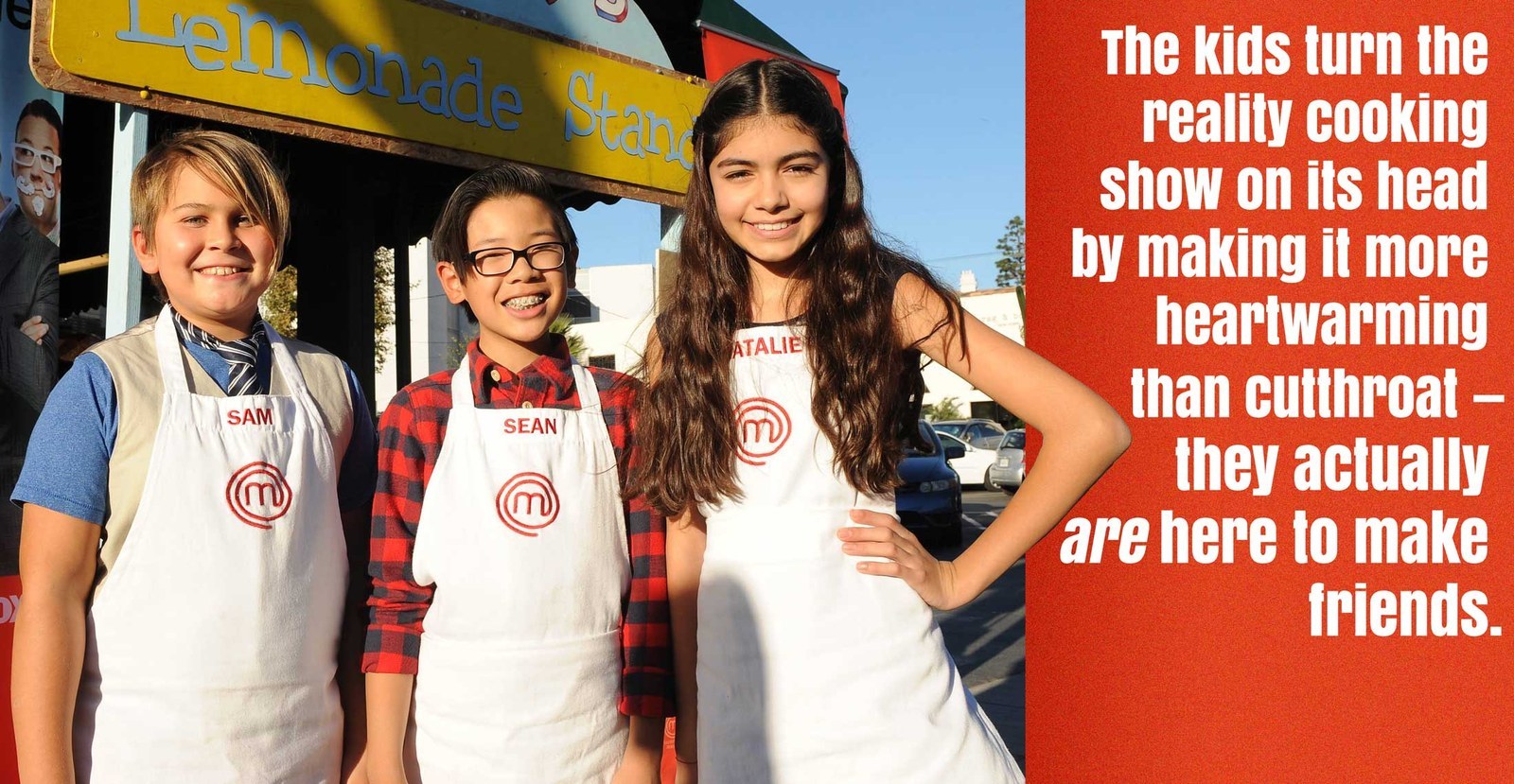
Like many of our reality shows, MasterChef is a European export. The adult version is based on a BBC show that initially ran from 1990 to 2001, and the brand was exported globally. More than 40 countries have adapted the show — there’s a MasterChef Italia, MasterChef Pakistan, MasterChef China, and more. The kid spin-off was first introduced in 1994 in the U.K. and has been produced in 15 different countries.
Even so, the American show’s executive producers Robin Ashbrook and Adeline Ramage Rooney, who also produce on the adult version, say they had a hard time getting Fox to sign on for Junior.
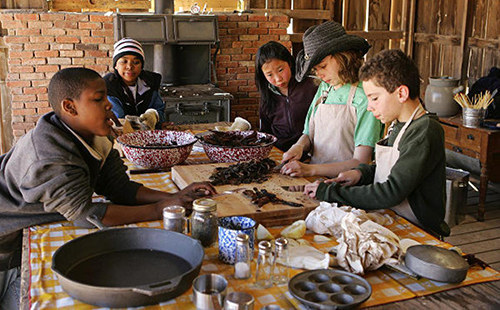
The not-distant memory of CBS’s failure with Kid Nation must have been a consideration. The 2007 show put 40 children ages 8 to 15 in a New Mexico ghost town and asked them to create a viable society without adult supervision, then was canceled amid allegations of child abuse, child labor law disputes, and a New York Times article about the insane contracts the parents signed. That same year, Bravo ordered eight episodes of Top Chef Junior with 13- to 16-year-olds, which never aired. (Bravo did not respond to a request for an explanation why.)
“You could go to anybody in the world and go, ‘Right, so we’ve got Gordon Ramsay,’ and they’d go, ‘But he shouts at people,’" Ashbrook says. "And you’d say, ‘And we’ve got this show with ovens and knives and hot dishes — and then we’re going to do it with kids.’ So on that pitch you’d be like, ‘You’re fucking out of your mind.’"
In 2012, while taping the third season of adult MasterChef, Ashbrook and Rooney taped a mystery box challenge with a group of kids — each got a box with the same surprise ingredients and had to create a dish. They sent the tape to Fox. It worked.
When the casting call went out, the press was especially critical that the kids would be as young as 8. But Rooney says having younger kids for MasterChef Junior was essential.
“Once you get to 14 to 17, they might be more skilled, but they’ve also kind of shut down a lot more,” she says. "So they’re not as good for TV, frankly."
The rest of the show is almost identical to the adult version of MasterChef, which just aired its fifth season. The other two judges are New York restaurateur and winemaker Joe Bastianich and Chicago chef Graham Elliot. The set’s the same, the format’s the same, and the production, editing, and culinary team are almost exactly the same.

“We want it to be a show that is co-viewed with parents and that our Hell’s Kitchen fans would watch, so we didn’t want to neuter Gordon,” Rooney says, referring to one of Ramsay’s other four shows currently on Fox in which he verbally abuses aspiring chefs cooking in competition for a job at one of his restaurants.
The Gordon Ramsay who appears on MasterChef Junior is a completely different judge — helpful, goofy, and sweet — so that you start to understand why some of the people who work for him show an irrational-seeming loyalty in the face of his insulting tirades and long list of scandals.
“Firm but fair. I liken it to a soccer coach,” Ramsay says of his attitude toward the kids on the show. “If you want your child to succeed — a ballerina, become the next basketball superstar, or play for the Dodgers — then you will push them.”

The eight kids who remain in the competition on Episode 4 in Season 2 stand in a row in front of a stage where the three judges are also standing in a row. They’re on a set on the Paramount lot in Los Angeles where they’ve been staying at a nearby hotel with their parents for the first two weeks of the three-and-a-half-week production. They’re ready to find out what the first challenge of the episode will be.
Ramsay’s voice has more bravado and is much louder than the other judges'. He wanders around set with an enormous, devious presence that makes even off-camera moments feel like reality TV.
A production guy coming from the behind-the-scenes kitchen rolls a cart near the set and tells me to be careful, please don’t put your coffee on this. Covered by a cloche, this plate is handed to the judges a minute later when they announce the challenge.
“There is one ingredient that every chef relies on,” Ramsay says. His voice rises with booming excitement to build the moment where he lifts the cloche: “It’s simple. It’s glorious. And delicious! It is an…egg.”
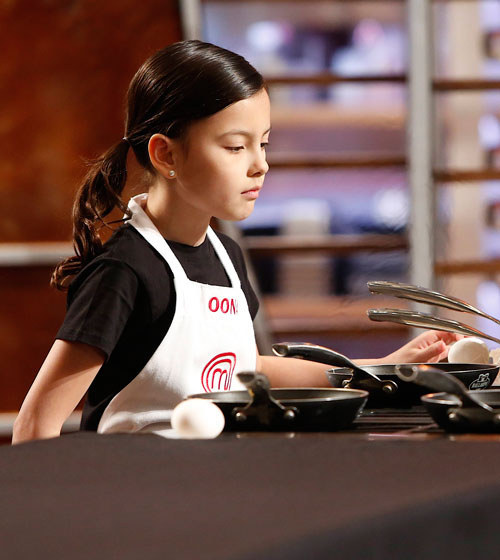
“Duuuuuuuh,” says Oona, an extremely bright 9-year-old with big eyes and dark hair pulled into messy pigtails. Oona’s favorite TV show of all time is Alton Brown’s Good Eats; she’s seen every single episode and most of them several times over. Oona’s dad, a Yale Law School professor, says he wasn’t inclined to let her watch MasterChef Junior when the show first came out: “My picture of reality TV was snarky adults saying mean things to each other,” he says. “We didn’t want her to see that.” But the show wasn’t that, so he and his wife agreed to let her watch it.
Bastianich, the third judge, begins to describe the sunny-side-up hero egg: “Notice there are no brown edges, there are no wobbly whites,” he says. “They're not snotty or runny.” The words “snotty” and “runny” are too much for some of the kids, and they burst into giggles.
Then there is a confusing silence for a minute or two. The judges have earpieces to receive stage directions during taping from producers in the control room who tell them what to redo. By now, the kids are used to these awkward pauses, but they are kids: They have a hard time standing still. Actually, so does Gordon Ramsay. Similarities between the celeb chef and the children are shockingly clear in person: They love to make trouble, they have scary amounts of energy, they get bored easily, and they throw temper tantrums.
All of a sudden the judges are alert again and Elliot starts talking: “You will have 10 minutes to make us as many perfect, sunny-side-up eggs as you can,” he says. “At your stations you will find everything you need: oil, butter, and a whole lot of eggs. You'll have eight pans, which I highly recommend you use simultaneously. Every perfectly fried sunny-side-up egg that we decide is good enough will give you a huge advantage in the upcoming challenge.”
Then, it seems like it’s go time: The cameras start moving and the kids begin to run to their stations. But the producers yell, “Can I have the kids back up at the front?” and the judges take a break. What the kids will do between finding out the details of their challenge and 20 minutes later when they start cooking eggs I don’t know, because Ramsay wants to chat backstage in another room and ushers me away.
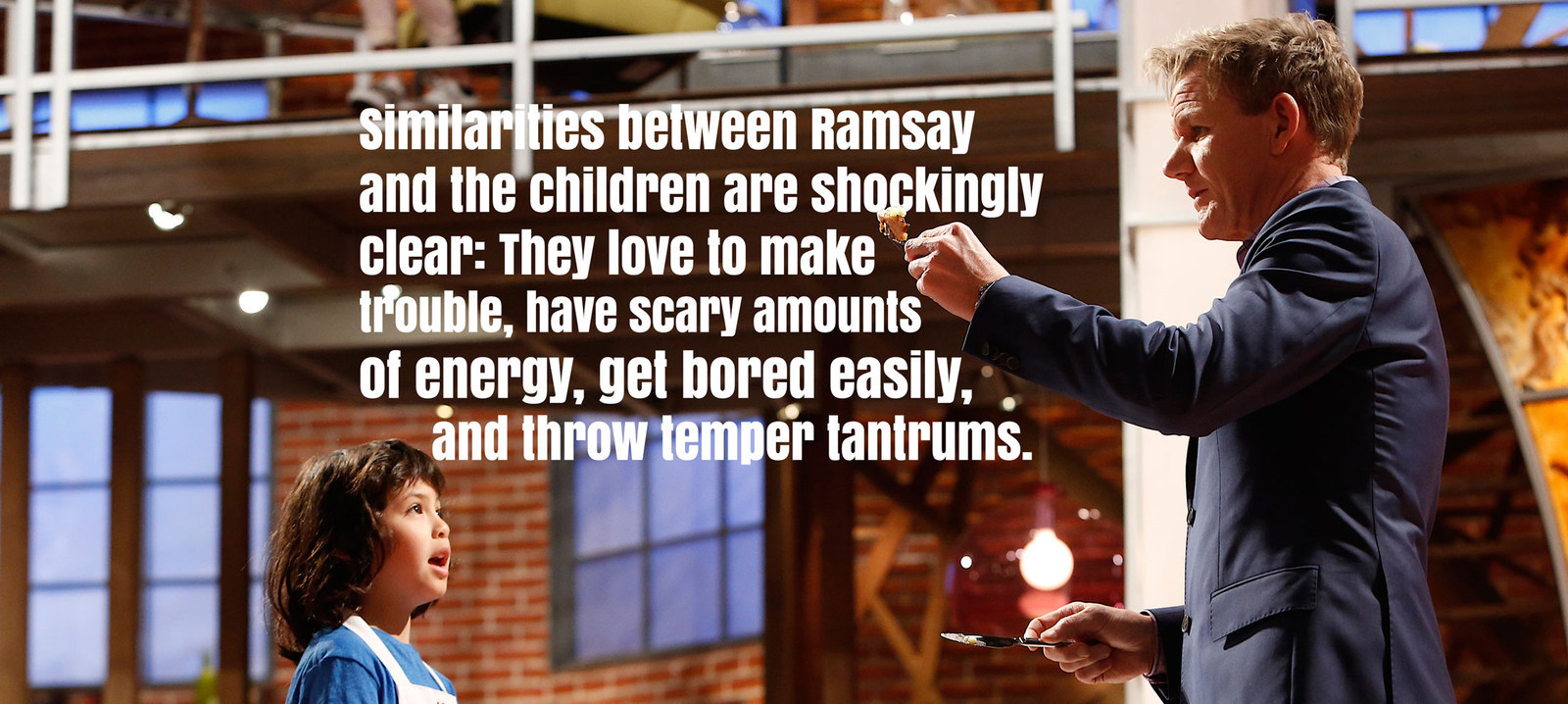
Gordon Ramsay is worth $47 million, according to Forbes. In addition to owning restaurants all over the world, he’s produced and starred in 23 television shows since 1999. He’s published 27 books, has a line of tableware with WWRD (Waterford, Wedgewood, Royal Doulton), and has so much energy that you feel rushed to keep up with the cadence of his speech and under pressure to keep his attention. His attention is actually impossible for anyone to keep most of the time. Even his own thoughts don’t keep his attention long enough for him to properly finish them.
“I absolutely 100% categorically submerge myself in the, you know, I don't give a shit what's going on outside, there could be a crisis — last week we got a stupid lawsuit issued over a total ridiculous, ridiculous place, there's a big conference call tonight where we are putting the defense together. It's just if there's one thing that always puts me off about working over here [in the U.S.] it's that the more popular and the more famous you become then the more litigious and the more small excuse people take as advantage to sue...”
The way Ramsay talks is part of his manic power. He has the same force to his speech as on television, but without an editor to cut it and make it coherent. He spits out raw quotes that apart might be worth something, but together become extremely confusing.
“...so that's one thing I've learned over the last decade. In terms of everyone says hey and of course the British press 'he's been sued again, that's 14 times in 7 different countries!' It's a joke. Whatever crap’s going on there, when I walk in here and I'm with these guys, they've got me 100% because it is so important; look at the sort of rip-offs already in terms of Food Network and Bravo now, and the amount of people that try to imitate, and you've got that sugarcoating ass-kissy, let's get all gooey and this is real — this is seriously real.”
He says he is involved in every aspect of the show, including casting, to identify the kids coming from desperate stage moms who aren’t really passionate about cooking. He was not fazed by initial skepticism about his working with children. “I’m a father of four and there’s no script for being a parent.” He talks about his own children a lot; they are between the ages of 12 and 16 and they are all over his Instagram feed amid pictures of him getting in race cars, getting on helicopters, and training for the Ironman.
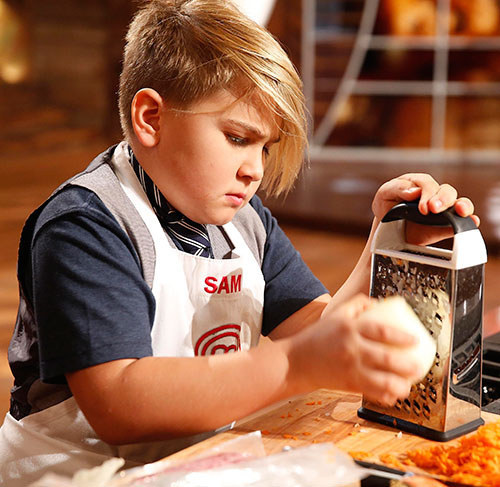
The kid contestants idolize Ramsay. Logan, for example, says Ramsay’s opinion is the only one that matters during judging. Logan’s mom tells him to try to not look so pitiful during taping that he gives her a heart attack every time he looks at the camera. Logan says he’s probably just bored because judging takes so long.
“He’s the best chef out of all three of them,” says Sam, a blond 9-year-old contestant from Reseda, California, who has a Skrillex-like hairstyle. Sam says he knows Ramsay’s the best chef because “he’s done so many TV shows and so many things like that, and you can see he looks so good as a chef.”
“Bless him," Ramsay says about Sam when tell I him this later on. "I mean, that’s a bit of a wrong interpretation. There needs to be an actual passion there, and that’s what we weed out very quickly."
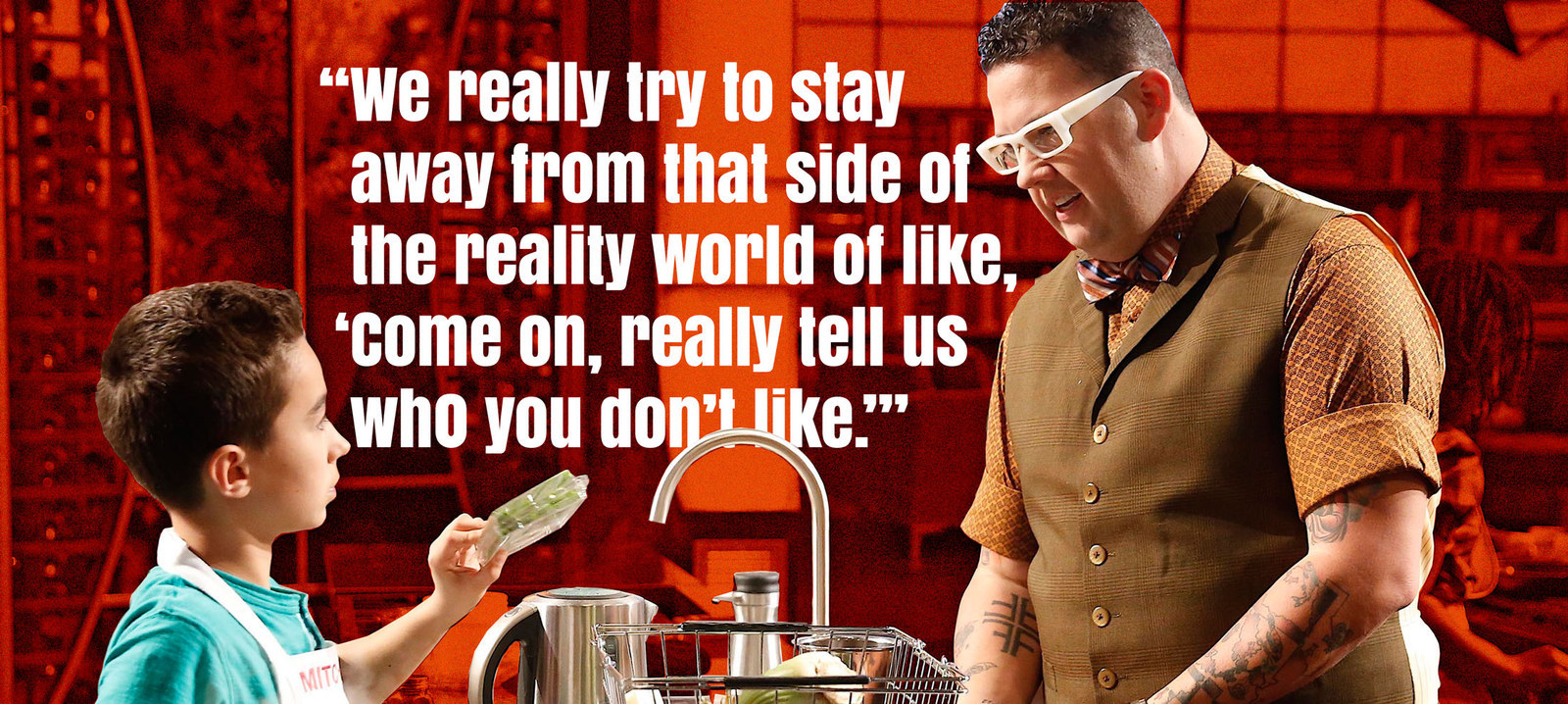
After this quick break, 10 minutes are set on the MasterChef clock, which hangs high in the middle of the room. The kids run to their stations and begin furiously cracking eggs into pans.
Ramsay, Bastianich, and Elliot stand on the stage, still being filmed, talking about the best techniques for making eggs. Bastianich suggests frying two eggs in one pan; Ramsay is horrified and pokes fun at him. Ramsay explains that the most important element here is actually the butter: You have to baste the eggs, spoon hot butter over the whites to cook the tops faster. Crack the egg low near the pan so the yolk doesn’t break; bring the plate close to the pan so you don’t have to walk around with an egg on your spatula.
“Four minutes gone!” yells Ramsay toward the kids. “Six minutes remaining! Speed up, guys, multitask.”
I’m standing near supervising culinary producer Sandee Birdsong, who is watching the kids closely and also has an earpiece and microphone to communicate with producers during taping. A former contestant on Top Chef, Birdsong is now also that show’s supervising culinary producer, and her job is to oversee all the food on the show — order equipment and ingredients, create and test challenges, and train the kids. After a minute or two she says quietly into the microphone, “Turn the heat down, all the kids are burning the eggs’ edges.”
A minute later, Elliot says to the kids from the judges podium, “Guys, make sure you don't get your heat too high, we don't want any brown edges, control that pan.”
Birdsong and her culinary team of as many as 26 people teach the kids cooking classes in between episodes, walking them through the techniques they need to succeed and giving them safety training. The MasterChef classroom is identical to the set — same ovens, same food processors — so the contestants can get familiar with the equipment. The culinary team squeezes in as many classes for the kids as they can given the short amount of time children are legally allowed to be on the Paramount lot every day. "The kids are here to learn as much as they can the whole time,” she says.
Birdsong says she doesn’t teach the kids exactly what to do for a challenge, but rather shows them a basic and (most importantly) the fastest way to accomplish things like make a sauce or filet a fish. There are lots of different ways to make a piecrust, for example, but one way is probably best when you’re racing the clock. The kids have the option of writing down and memorizing anything from class.
“We teach a very basic application that works in our environment and that’s what they tend to stay with, and it’s their choice if they go off that mark [during a challenge],” she says, adding that the adults who receive the same classes are more likely to revert to their personal cooking methods.
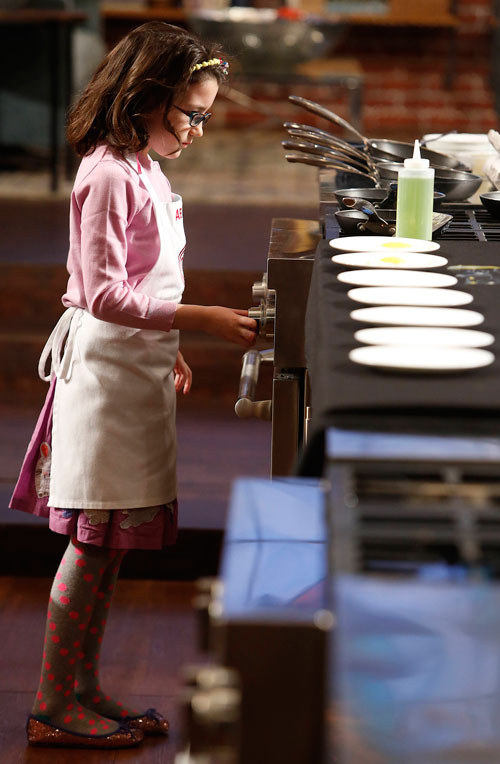
Halfway through the egg challenge, Ramsay takes an interest in Abby, the youngest contestant at 8, who’s got her pan too hot and is still struggling to get a single egg fried and on a plate. Abby, who's from Winchester, Virginia, still has a sweet baby-talk quality to her voice and is impossibly adorable. In Episode 2, while watching the other kids race to cook pancakes, she screamed nearly every time a pancake was flipped over and at one point nearly collapsed from excitement. “Take the pan to the plate, young lady,” Ramsay tells her.
She yells back, clearly stressed: “IT’S NOT READY.”
When time’s up, the judges all count down the last 10 seconds together.
The kids raise their hands in surrender and stop cooking.
“Who’s feeling good, guys?” Ramsay asks, cheerfully. No one raises a hand. The kids’ mood is total frustration. “Aw, come on, no one?”
A producer hollers from the side, “Let’s do the last five seconds again, guys,” and on cue the kids pretend to plate eggs and run around while someone counts, “Five, four, three, two, one.”
Then the kid chefs are shuffled out of the room for a break. Instead of the judges going to inspect the eggs, Rooney emerges from the greenroom and walks station to station to see who cooked the most eggs.
After the numbers are calculated, Birdsong, Elliot, Bastianich, and Rooney sit at a table offset discussing how to make the next challenge work. As it turns out, the number of eggs each kid cooked in this first challenge will determine the number of ingredients he or she will be allowed to use to cook a signature dish. Little Abby, sure to be an audience favorite, has successfully fried only two eggs in 10 minutes.
The lights on the set go dim; the pans and eggs and dishes are being cleared away. Out of the blue, Gordon Ramsay makes an announcement:
“The lady from BuzzFeed is going to do the egg challenge.” The cameramen, producers, and crew are as surprised as I am. “Lights up, please, thank you,” he hollers at no one in particular.
The kids aren’t present and the cameras aren’t rolling. And though I’ve been hanging around the set of his show for two days, I don’t think I’ve done anything to make him want to actively embarrass me. We had so far spoken innocuously about this show and his own children. I had not even asked him about the time he fat-shamed a contestant on Hell’s Kitchen, nor the time he tricked vegetarians into eating meat, nor about his allegedly showing up with a camera crew without permission at the wedding of his now-estranged mentor Marco Pierre White. I did not ask if he actually hired someone to film his father-in-law (and former business partner) having an affair, or if any of those things make him feel any doubt that he should be a role model for children.
But Ramsay’s probably just bored; he doesn’t want me or anyone getting too comfortable, and he knows this will be fun. And he does not know, thank god, that I attended culinary school. In theory I should be decent at this. But I'm not. I can’t be relied on to do anything quickly — not cooking, writing, thinking, or any kind of thing. I accidentally set my course book on fire more than once.
Ramsay abruptly starts singing “If I Could Turn Back Time” and rushing the producers to bring over the pans, oil, eggs, and butter. "Get the clock ready. You have five minutes. Are you ready? Five minutes, I want to see how many you can do. Your time starts now.”
“I'm shaking,” I say.
“And begin!”
I start cracking eggs into the pans without remembering to turn on the heat under any of the pans.
“Turn the gas on first, young lady! Fifteen seconds gone! Let's go, let's go, let's go! Thirty seconds gone.”
“Shit!”
“Please no cursing, Emily. Forty seconds gone.”
“OK, OK.”
“Darling, you gotta go faster, I am starving. Coming up to one minute gone. If an 8-year-old can do it, I'm sure a 22-year-old can do it.”
I am 31.
But there is a crowd of about 20 people from the crew watching, taking photos with their phones, and laughing.
“Emily, I'm begging you, turn the fucking gas on.”
“No cursing, Chef,” I say.
“Coming up to two minutes gone. EMILY, PLEASE,” he yells. I am still not even finished cracking all eight eggs into all eight pans because I have apparently forgotten how to crack eggs, what to do with the shells, how to pan, what are eggs.
“What if I just throw one of these raw eggs at you,” is for some reason my response.
“Please, Emily, don't waste time. I've got your editor on the phone, he's live and he's not impressed.”
I consider telling him that my editor is a woman. I don’t really want to embarrass him and make him yell even more. Or do I?
“My editor is a woman,” I say, cringing.
“Well, she's not very happy. We're Skyping her straight after this. I BEG YOU, GET ONE FUCKING EGG ON THE PLATE, PLEASE.”
I remember I should throw some butter in there and baste.
“Nice, that's lovely. Butter, butter, butter,” he says three times rhythmically. I’m reminded of the way he also offhandedly said, “To the bar. The bar, the bar, the bar,” three times earlier in the day.
“Seventy-five seconds to go!” he yells.
This is the part where, if you’re a real cook, your brain turns off and your muscles remember and everything’s familiar so you can work like a machine. You can rhythmically baste, tilt, scoop, and plate along a row over and over with movements so efficient that 75 seconds is the perfect amount of time to plate eight sunny-side-up eggs. But the kids don’t have that muscle memory, how could they, and neither do I. No one is magically a master chef. It takes practice.
Ramsay, I’ve realized by now, needs to yell the whole time and doesn’t like silence, so he says, “Coming up to 60 seconds to go! EMILY, PLEASE.”
I get an egg on the plate.
“ONE EGG, YAY!!!!!!” he says sarcastically. “Last minute!”
The rest of the eggs just haven’t finished cooking. I have spent most of my five minutes fumbling with the heat and running back and forth between my two ranges of four eggs each.
The entire production crew of MasterChef Junior counts down my last 10 seconds.
“One egg. You are as good as Abby,” he says.
Abby, he reminds me, is 8 years old.
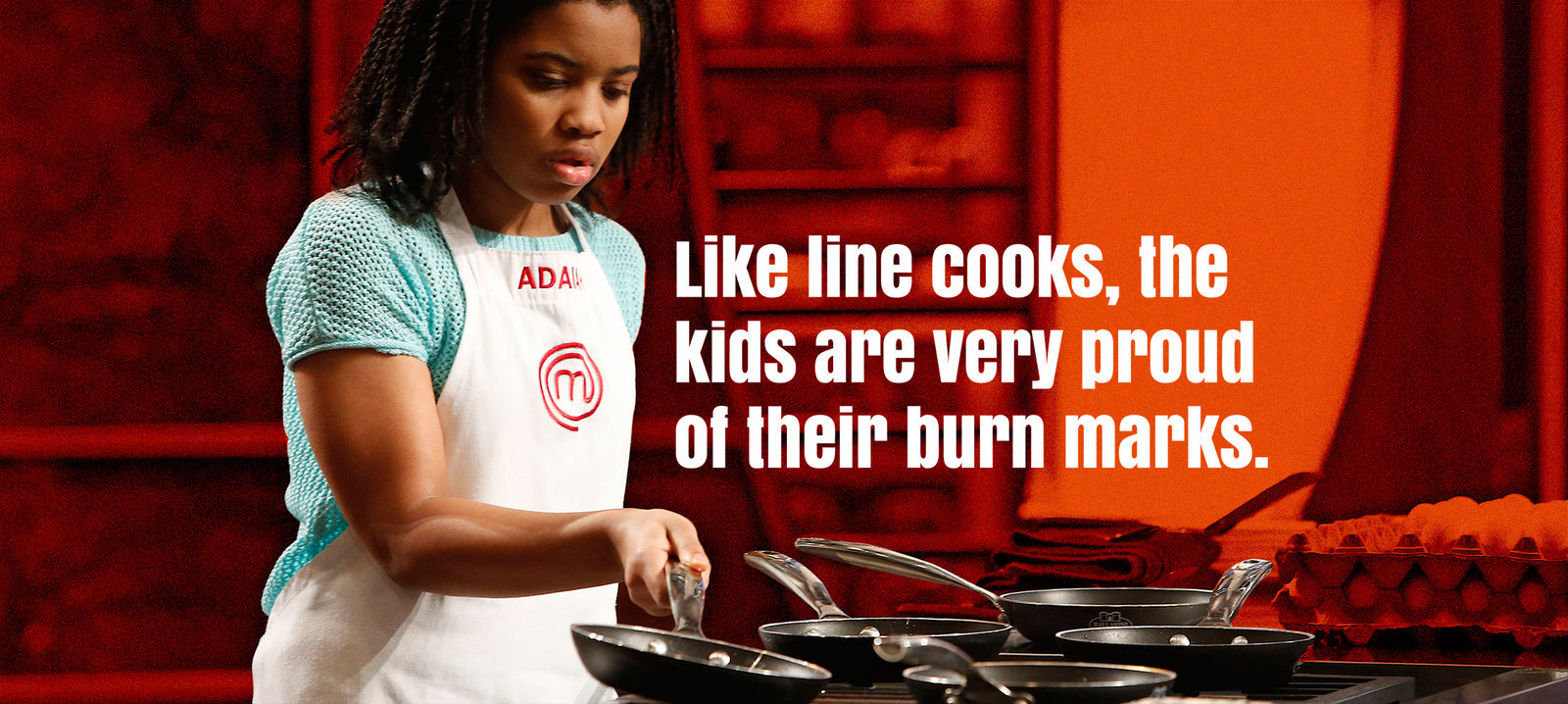
“I snuck some of your frosting one time,” Abby says to Samuel, a jaunty 12-year-old who talks like he’s doing an impression of an adult on a cooking show. To me, she adds, “I wanted to see if it was good because he wasn’t called for the top three in the cupcake challenge.” She is wearing tiny glasses, head-to-toe pink and purple with ruffles, polka dots, and tiny sparkly shoes.
The kids are sitting (sort of — Oona is bad at sitting) at a table in a break room in a building separate from the set. This is where their parents hang out during episode tapings.
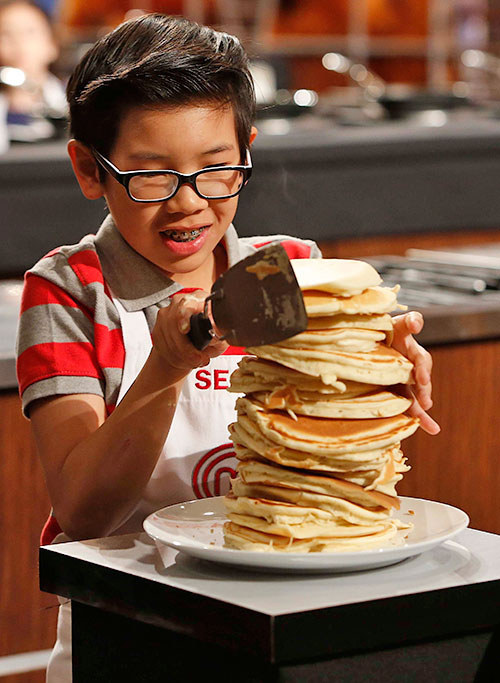
Noticeably quiet during breaks is Sean, an Asian-American 12-year-old from Santa Ana, California, with thick glasses, braces, and a big smile when he lets it show. Sean has won the most challenges, and the other kids think he’s the best cook because, as one of them says, “He’s been cooking every night for two years.” Sean is quick to correct him: He cooks only three times a week. His dream is to be a restaurant owner and an interior designer because he “spends half his time on Pinterest looking at home decor.”
The kids are, in fact, really sweet to each other. And the adults encourage that.
“We really try to stay away from that side of the reality world of, like, ‘Come on, really tell us who you don’t like,'" says Elliot the next day. "'This one said this about you, you should really say...’ There’s nothing like that. You ask, ‘Who do you think is the best? Who do you not want in here?' And almost 90% of the time it’s, ‘I like everybody, they’re all good.’”
Ten-year-old Josh, who has long hair and a crackly voice that sounds a little like Jonathan Taylor Thomas, offers a story about how Ramsay helped him roll out a piecrust because he couldn’t do it fast enough. While Ramsay’s helping him didn’t appear in the final episode, the producers did include another special moment: Josh, seeming very, very concerned, says he really hoped he wouldn’t get sent home for his Key lime pie because that would ruin his feelings about Key lime pie.
Oona hollers loudly so she can be heard over the other kids who have all started talking vaguely about piecrust at once: “Half a cup of butter and 2½ cups of flour and 2 tablespoons of sour cream.” She is the only one who offers specifics, and that ratio would probably work. Oona had never made a pie before she got to MasterChef; she learned in Birdsong’s classes.
When I ask about burns, almost all of the kids eagerly and immediately shove their forearms toward me to show off burn marks. Some got these during the show; some were earned while cooking at home. Like line cooks, the kids are very proud of their burns.
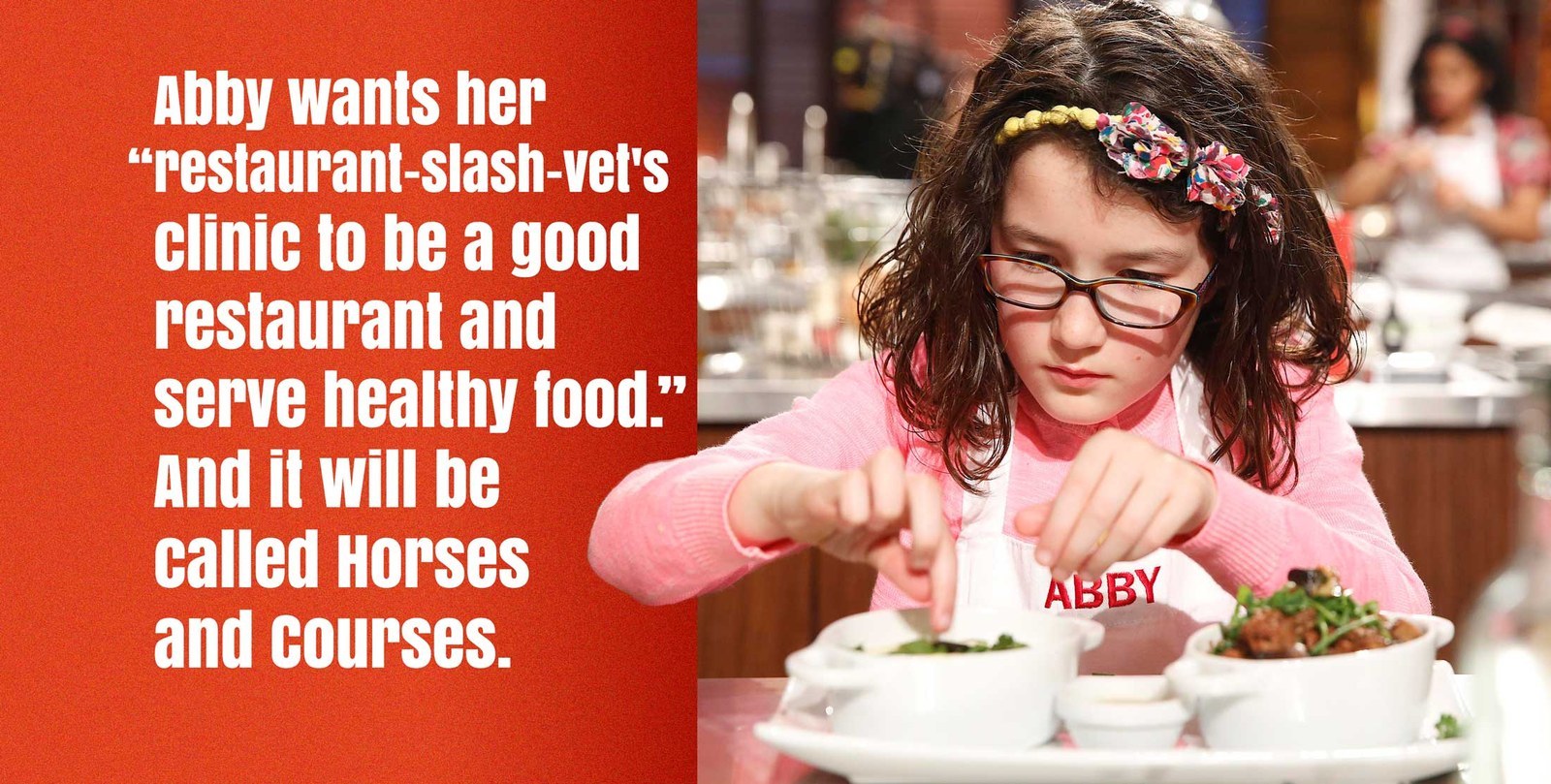
“In this next challenge we want all of you to dream big and imagine owning and running your own restaurant,” says Ramsay to the kids, now back on camera. "Excited?"
“Yes, Chef!” The kids know to yell in response.
Oona’s signature dish at her someday restaurant (which will only serve “well-to-do people”) will be scallops two ways: scallop crudo with a yuzu ponzu sauce and crispy wontons, plus seared scallops with a soy foam and a ginger scallion oil.
But Oona’s only fried four eggs, the judges point out, so now what?
“I’m just going to do the seared scallops because that shows more skill…or I’ll... I don’t know,” Oona says, smiling without a trace of the worry an adult in her position would show.
Later, Ramsay tells me that he helps them before they kick off the pantry run and cooking, “just to stop them from panicking.”
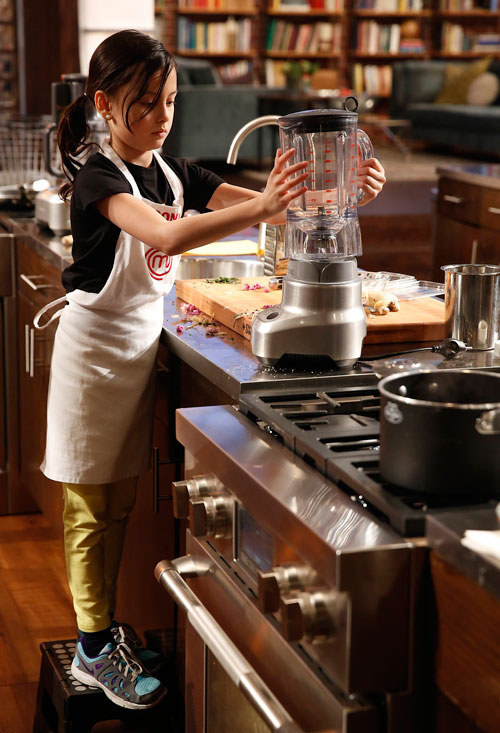
“She needs to understand that you got four ingredients, so it's scallops, cauliflower, grapefruit, and I think orange segments,” Ramsay says. “So the cauliflower puree, Oona wants cream in there. There's no greater way to do a cauliflower puree than to take the florets, blanch them in rapidly boiling water, get them just cooked, take them out, blend them, and add the water they were cooked in back to it. So those kind of techniques is what I need to step in and say, ‘Get concerned but don't get upset.’”
Before they film the pantry run, there’s an off-camera “culinary pause” and Birdsong goes from kid to kid asking them exactly what ingredients they are going to get and what they will plate. She’s writing it down and either giving them advice or just flat-out telling them what to do. The producers are getting impatient — they need to make this quick — but Birdsong is determined to make sure the kids know what they are doing.
“What’s your starch going to be?” she asks one of them.
“Do I have to have a starch?” he says.
Sean, who has successfully fried the most eggs with his 10, is playing the hand-slap game with Logan while Birdsong tries to get them to focus.
The PR person trailing me is looking around for a senior production person to say if it’s OK that I am watching this happen.
Once the clock starts, the kids have an hour to cook. Bastianich immediately goes over to Abby, who has only two ingredients: salmon and asparagus.
“We never cook for them,” Gordon says later, adding that there was a moment in another challenge when he helped Abby cut butternut squash because he felt she was about to slice her hand open. “We help, we advise … my job is to protect them, health and safety.”
While most of the kids specified that their restaurants would be expensive and serve “rich people,” “fancy people,” or “investment bankers,” Abby wants her “restaurant-slash-vet's clinic to be a good restaurant and serve healthy food.” And it will be called Horses and Courses.
“Um, how about getting a pan out so we can start thinking about this?” Bastianich says to Abby, who, if she wins, says she will give the $100,000 prize money to charity after she buys a horse. “How are you going to do the asparagus?”
“I’m gonna sauté and boil them,” she says.
“That’s a good idea, boil them first so you know they’re cooked then sauté them with oil and salt and pepper to give them a little flavor … Oops, they’re too long to fit in that pan...”
One of the kids cuts herself and two medics rush in with Band-Aids and antiseptic.
Birdsong and the other producers say they take every precaution to keep the kids safe and reassure the parents with fully trained medics always on site, knife and open-flame safety classes, and judges who will step in to help. But at the same time, the episodes definitely play with the peril of kids fumbling with giant food processors stored on high-up shelves and handling knives as big as their arms. Because that’s the rule: Treat them the same as the adults.
“I mean, obviously we all cringe every once in a while when they're holding the knife wrong or they grab something and it's hot or they're fixing to do something and it's scary,” she says, “but we're there, and [the parents] know we're there.” The judges will intervene and help, Ramsay says, if they see a child doing something that seems too dangerous.
The most common injuries, Birdsong says, are small burns, because the kids often forget when they pull something out of their oven and put it on the counter that it’s still hot and touch it later. She trains them to put a towel on any hot pans as a reminder.
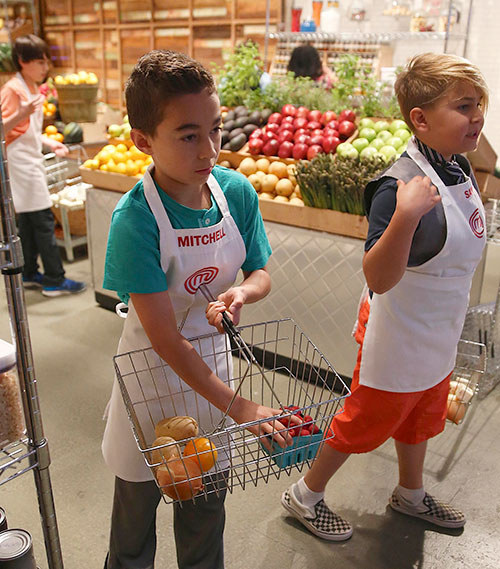
Adaiah hollers that she needs an adult to open a jar for her. That’s allowed, and a culinary producer steps in. But when Samuel asks if he can go back in the pantry because he got a wrong ingredient or something, it’s not.
“They try to break the rules when they can,” Birdsong says. She is always impressed with how much they are capable of in technical classes and during taping. “It’s easy because they’re kids, so they learn quick. They respond, too, if I told them to do something right — now they’ll remember that forever.”
Oona is blending her cauliflower puree nearby and Birdsong silently motions to her, mock-sprinkling her hand, giving her the universal symbol for “don’t forget to salt.”
“She had extra time, so she did make her scallops two ways,” whispers a producer into her earpiece microphone, talking about Oona. “She just didn’t make the foam.”
There’s not really a sense of last-minute panic that the TV show conveys as the kids begin to plate. They’ve been able to finish. This, too, is part of Birdsong’s job: The producers rely on her to design challenges that are as short and as hard as possible so that “the hands-up moment is really a hands-up moment,” she says. And she tests the timed challenges before each taping the exact same way for the kids and the adult contestants “because the kids are just as good as the adults.”
The kids finish cooking and the PR person who trailed me while I was there asks me to step out of the building with him. This was quite obviously a pivotal moment and I wanted to see how the judging went down, so I asked why I had to leave, and he said that they didn’t want the show “to get overexposed.”
Optimistically, what was happening was that the judges and producers were looking at the kids’ plates and figuring out who would win and who would go home, and maybe cleaning them up...a little.
After about 25 minutes I'm let back inside; the judging portion has started.
Birdsong is now holding a piece of paper with quickly sketched drawings of all eight kids’ plates on it, and as one of the kids places his plate in front of the judges, I hear Birdsong say into her mic, “That plate needs a spin.”
Seeing those sketches, I think of the extra kitchen I had seen backstage, the one where a small staff of busy adults was talking about tempura batter recipes from various L.A. restaurants. Could they possibly cook all the food after Birdsong talks to the kids before the pantry run, just in case?
“Oh, no way, we wouldn’t be able to do that,” says Birdsong. “We have someone from legal at every single production day and they would not allow something like that to happen. We’re governed by that.” Birdsong says the parents are also introduced to the legal team and can at any point during taping ask to speak to them.
Even so, I wanted to go and look in that kitchen, see how busy they had been while the kids had been cooking, and what was in their trash. But I couldn’t: The PR person babysitting me was going to shepherd me to the next interview then directly to my car in the parking lot.
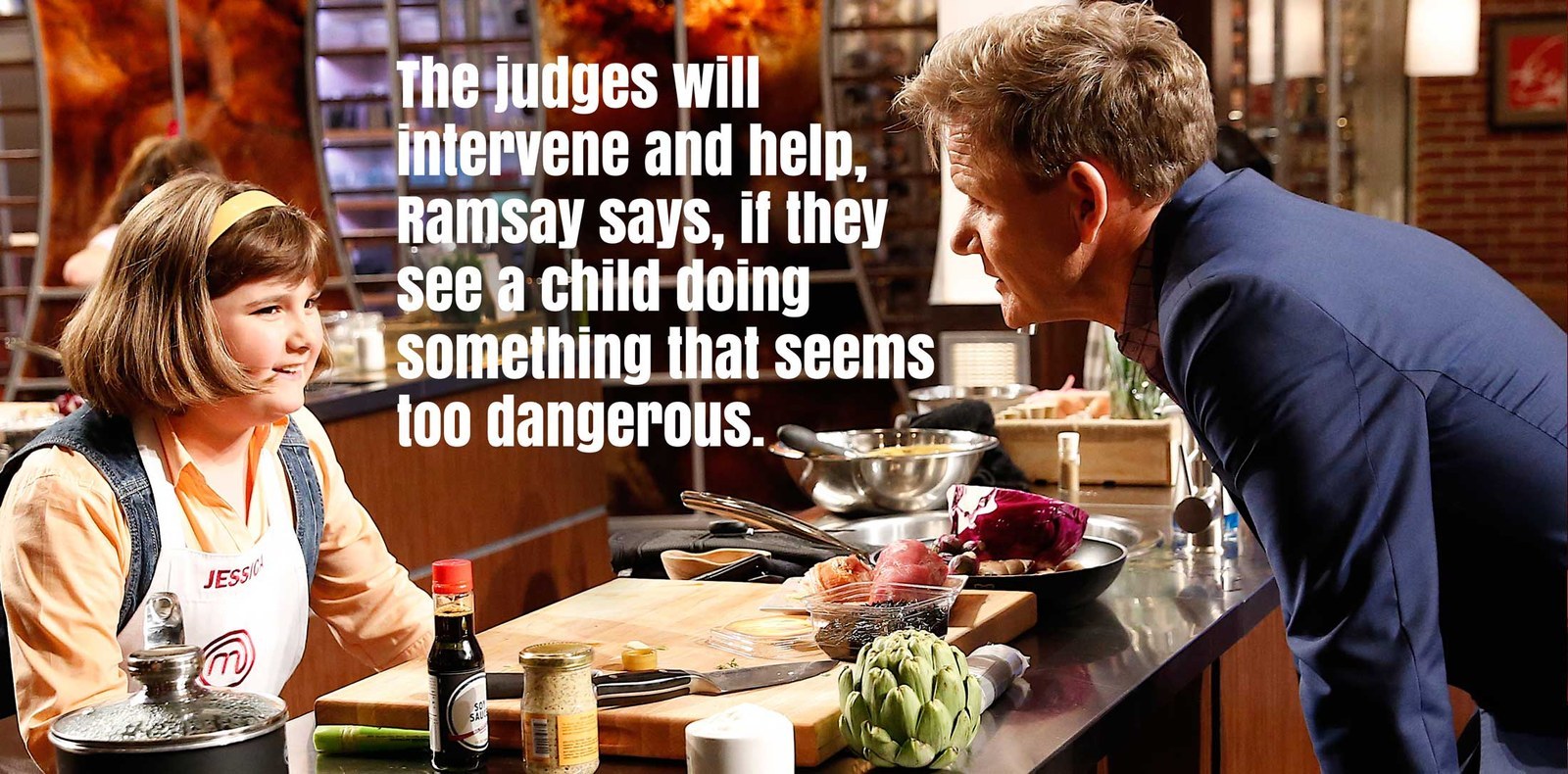
After the judging, little Logan in his bow tie with his underseasoned rice is safe. But two other contestants are sent home. The producers intentionally send kids home in pairs to make it easier on them.
In one episode, a girl who was sobbing when she’s told she’s being eliminated is five minutes later smiling and says, “I am sad I have to leave but I’m excited to go home and see my dad and my dog.”
I sit down with Elliot and Bastianich on some couches near the set. Taping is done for the day. They look exhausted. Elliot wipes his face, forces a cheerful mood, and tries to be friendly. Bastianich doesn’t look up from his cell phone.
“What you just saw was challenging, goddamnit,” says Bastianich. “Sending these kids home is horrible; it’s hard.”
I ask point-blank if anything is done to the food before the judges judge it.
“No,” says Bastianich, still on his phone. “It is what it is.”
He seems relieved for Abby, who was not sent home. “You know, whether she cooked that salmon perfectly by accident or not, but she cooked it better than a 12-year-old boy did."
I ask if they think all of the kids will really become chefs one day. They say no, of course not all of them, and they’re not trying to push restaurant work on them. This gets Bastianich’s attention.
“I think the more relevant question is the 6 million kids and adults who are watching,” he says, seizing an opportunity to give a positive spin and talk about something he’s proud of. “What message does that send to them, because that’s the greater impact, right? I think it’s a very positive one. We think that this is the cure, not the problem, for food-related issues in our society — whether it’s childhood obesity, whatever — knowing about the food, how to cook it, how to source it, how to manage it, is a very positive message that these kids launch for everyone else.”
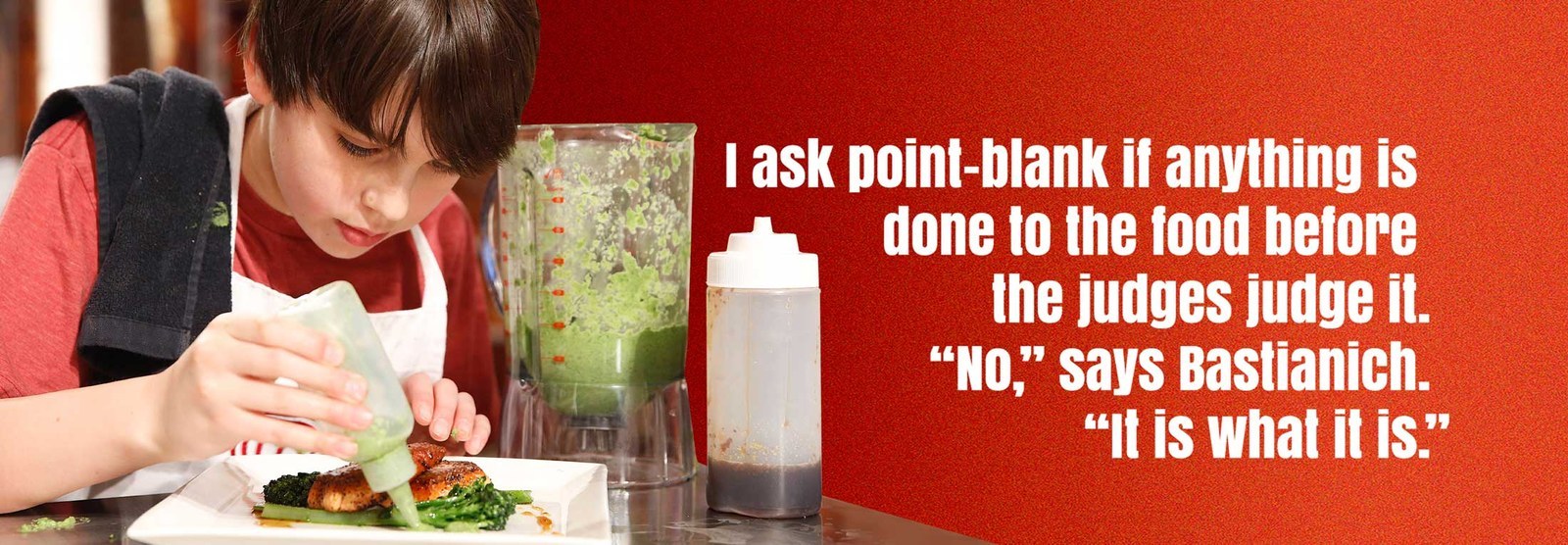
A few months later I reach out to Jack, a contestant from Season 1, and ask his mom if I could visit them at home. I want to see how well he can actually cook.
A 12-year-old seventh-grader now, Jack was 10 when he taped the show in 2013 and ended up an audience favorite because of his New York accent, the colorful Hawaiian shirts he wore on every episode, and his maniac chopping skills.
At his neighbor’s beautiful, two-story home in Far Rockaway, New York (their house is under construction, his mom says), Jack is going to sear a thick steak with a coffee and cacao powder rub and roast some butternut squash.

“I’m going to try to cook it medium rare, so it’s a nice brown on the outside but pink to red color in the middle, because I feel like it allows the beef’s natural flavors to shine through,” he says.
Will he use a thermometer?
“I just go by touch,” he says, pointing out the “nice brown color” that’s developing as he sears not just two sides but every surface of the steak, standing it up vertically and letting it rest on the side of the pan, which most adults would not think to do.
“I actually prefer it on the pan than cooked on the grill,” he says. “It tastes more elegant.”
It’s been two and a half years since Jack taped MasterChef Junior and he’s still obsessed with cooking, though he also plays tennis, the trombone, and the piano, and says he’s into wrestling. He still has his adorable smile but is in the middle of a preteen growth spurt; something about the ratio of his calves to his feet gives away that he might be a lot taller very soon.
Jack holds the knife properly; he’s stacking parsley leaves one on top of the other, rolling them into a cigar shape then slicing through the roll for a proper chiffonade. This technique is something I couldn’t tell if the kids I saw during the taping were doing because I couldn’t get close enough. Unlike Alexander, the 13-year-old who won the first season, Jack has not been staging at restaurants like Del Posto and Lure Fishbar.
My paranoia about the realness of the show is fading. This child is a very good cook.
The major thing he learned on MasterChef, he says, was time management. “I learned that you should always heat up your pan before you heat up the oil, because if you don’t then the oil can burn on you. That was big.”
Jack starts to loosen up, talking about cooking with a lot of authority, and I realize he narrates each step like a TV personality. “So we’re just going to let this [steak] sit here for a little longer, to let it cook a little bit, and then we’ll put it on here [a cutting board] to rest...”
Then all of a sudden he’s a kid again: “...Umm, so, because if you didn’t let it rest once you put it on the plate it just sort of, like, all the blood just, like, squirts out and it looks all red on your plate and everything is ruined and it’s horrible and you’re like, ‘No!’ But when you cut the filet mignon on the board, all the blood comes out on the plate so when you put it on your real plate, then it looks perfect.”
He, like Oona, learned most of what he knows about cooking from television. “One day I just turned on the TV and Chopped happened to be on there and I didn’t feel like getting the remote and changing it to cartoons, so I just kept watching Chopped.” So basically, food TV is responsible not only for breeding the next stars of food TV, but also, maybe, causing children who might otherwise beg for processed fast food to want to help cook dinner from scratch.
After carefully examining his steak to find the grain, Jack slices it to reveal a perfect medium-rare. He plates slices artfully next to his cubed butternut squash then wipes the sides of the plate like a cook at the pass.
